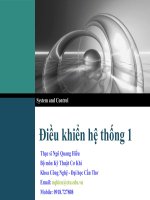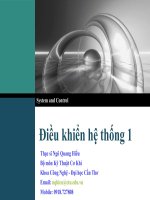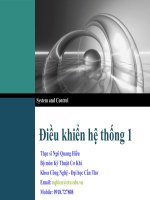66 12485 EC311 2013 1 1 1 chapter 4 piezoelectric ceramics
Bạn đang xem bản rút gọn của tài liệu. Xem và tải ngay bản đầy đủ của tài liệu tại đây (363.38 KB, 33 trang )
Piezoelectric Ceramics
EBB 443
Dr. Sabar D. Hutagalung
School of Materials & Mineral Resources Engineering, Universiti Sains Malaysia
Piezoelectric effect
Discovered in 1880 by Jacques and Pierre
Curie during studies into the effect of
pressure on the generation of electrical
charge by crystals (such as quartz).
Piezoelectricity is defined as a change in
electric polarization with a change in
applied stress (direct piezoelectric effect).
The converse piezoelectric effect is the
change of strain or stress in a material due
to an applied electric field.
Piezoelectric effect
The linear relationship between stress Xik
applied to a piezoelectric material and
resulting charge density Di is known as the
direct piezoelectric effect and may be written
as
where dijk (C N−1) is a third-rank tensor of
piezoelectric coefficients.
Piezoelectric effect
Another interesting property of piezoelectric material
is they change their dimensions (contract or expand)
when an electric field is applied to them.
The converse piezoelectric effect describes the strain
that is developed in a piezoelectric material due to the
applied electric field:
where t denotes the transposed matrix.
The units of the converse piezoelectric coefficient are
(m V−1).
Piezoelectric effect
The piezoelectric coefficients, d for the direct
and converse piezoelectric effects are
thermodynamically identical, i.e.
ddirect = dconverse.
Note that the sign of the piezoelectric charge
Di and strain xij depends on the direction of the
mechanical and electric fields, respectively.
The piezoelectric coefficient d can be either
positive or negative.
Piezoelectric effect
It is common to call a piezoelectric coefficient
measured in the direction of applied field the
longitudinal coefficient, and that measured in the
direction perpendicular to the field the transverse
coefficient.
Other piezoelectric coefficients are known as shear
coefficients.
Because the strain and stress are symmetrical
tensors, the piezoelectric coefficient tensor is
symmetrical with respect to the same indices,
dijk = dikj .
Piezoelectricity
The microscopic origin of the piezoelectric effect
is the displacement of ionic charges within a
crystal structure.
In the absence of external strain, the charge
distribution is symmetric and the net electric
dipole moment is zero.
However when an external stress is applied, the
charges are displaced and the charge
distribution is no longer symetric and a net
polarization is created.
Piezoelectricity
In some cases a crystal posses a unique polar
axis even in the unstrained condition.
This can result in a change of the electric charge
due to a uniform change of temperature.
This is called the pyroelectric effect.
The direct piezoelectric effect is the basis for
force, pressure, vibration and acceleration
sensors and
The converse effect for actuator and
displacement devices.
Piezoelectric and subgroup
The elements of symmetry that are utilized by
crystallographers to define symmetry about a
point in space, for example, the central point of
unit cel, are
a point (center) of symmetry,
axes of rotation,
mirror planes, and
combinations of these.
Utilizing these symmetry elements, all crystals
can be divided into 32 different classes or point
groups.
Piezoelectric and subgroup
These 32 point groups are subdivisions of 7 basic crystal
systems:
triclinic,
monoclinic,
orthorhombic,
tetragonal,
rhombohedral (trigonal),
hexagonal, and
cubic.
Of the 32 point groups, 21 classes do not possess a center
of symmetry (a necessary condition for piezoelectricity to
exist) and 20 of these are piezoelectric.
One class, although lacking a center of symmetry, is not
piezoelectric because of other combined symmetry
elements.
Piezoelectric and subgroup
32 Symmetry Point
Groups
21 PG: Noncentrosymmetric
20 PG: Piezoelectric (Polarized under stress)
10 PG: Pyroelectric (Spontaneously polarized)
Subgroup Ferroelectric (Spontaneously
Polarized, Revesible Polarization)
11 PG: Centrosymmetric
Piezoelectric and subgroup
As discussed in previously slide, piezoelectric
coefficients must be zero and the
piezoelectric effect is absent in all 11
centrosymmetric point groups.
Materials that belong to other symmetries
may exhibit the piezoelectric effect.
How are piezoelectric
ceramics made?
A traditional piezoelectric ceramic
is perovskite crystal, each
consisting of a small, tetravalent
metal ion, usually titanium or
zirconium, in a lattice of larger,
divalent metal ions, usually lead or
barium, and O2- ions.
Under conditions that confer
tetragonal or rhombohedral
symmetry on the crystals, each
crystal has a dipole moment.
Polarization of piezoelectric
Above a critical temperature, the Curie point, each
perovskite crystal exhibits a simple cubic symmetry with
no dipole moment.
At temperatures below the Curie point, however, each
crystal has tetragonal or rhombohedral symmetry and a
dipole moment.
Adjoining dipoles form regions of local alignment called
domains.
The alignment gives a net dipole moment to the domain,
and thus a net polarization.
The direction of polarization among neighboring domains
is random, however, so the ceramic element has no
overall polarization.
Polarization of piezoelectric
The domains in a ceramic element are aligned by exposing
the element to a strong, direct current electric field, usually
at a temperature slightly below the Curie point.
Through this polarizing (poling) treatment, domains most
nearly aligned with the electric field expand at the expense
of domains that are not aligned with the field, and the
element lengthens in the direction of the field.
When the electric field is removed most of the dipoles are
locked into a configuration of near alignment.
The element now has a permanent polarization, the
remanent polarization, and is permanently elongated.
Electric dipoles in Weiss
domains; (1) unpoled
ferroelectric ceramic,
(2) during and (3) after
poling (piezoelectric
ceramic)
Piezoelectricity
Domain Wall Movement
Piezo Materials
Some examples of practical piezo materials
are barium titanate, lithium niobate,
polyvinyledene difluoride (PVDF), and lead
zirconate titanate (PZT).
There are several different formulations of
the PZT compound, each with different
electromechanical properties.
What can piezoelectric ceramics do?
Mechanical compression or tension on a poled piezoelectric ceramic
element changes the dipole moment, creating a voltage.
Compression along the direction of polarization, or tension
perpendicular to the direction of polarization, generates voltage of the
same polarity as the poling voltage.
Generator and motor actions of a piezoelectric element
Piezoelectric ceramics- applications
The principle is adapted to piezoelectric motors,
sound or ultrasound generating devices, and many
other products.
Generator action is used in fuel-igniting devices,
solid state batteries, and other products;
Motor action is adapted to piezoelectric motors,
sound or ultrasound generating devices, and many
other products.
Definition of Piezoelectric Coefficients and
Directions
Orthogonal system
describing the
properties of a poled
piezoelectric ceramic.
Axis 3 is the poling
direction.
Because of the
anisotropic nature of
Piezo ceramics,
effects are dependent
on direction.
Definition of Piezoelectric Coefficients and
Directions
To identify directions
the axes, termed 1,
2, and 3, are
introduced
(analogous to X, Y,
Z of the classical
right hand
orthogonal axial
set).
The axes 4, 5 and 6
identify rotations
(shear).
The direction of polarization (3 axis) is established during
the poling process by a strong electrical field applied
between two electrodes.
For actuator applications the piezo properties along the
poling axis are most essential (largest deflection).
The piezoelectric coefficients described here are not
independent constants.
They vary with temperature, pressure, electric field,
form factor, mechanical and electrical boundary
conditions etc.
The coefficients only describe material properties under
small signal conditions.
Piezoelectric materials are characterized by several coefficients:
Examples are:
dij: Strain coefficients [m/V]: strain developed (m/m) per electric field
applied (V/m) or (due to the sensor / actuator properties of Piezo
material).
Charge output coefficients [C/N]: charge density developed (C/m²)
per given stress (N/m²).
gij: Voltage coefficients or field output coefficients [Vm/N]: open
circuit electric field developed (V/m) per applied mechanical stress
(N/m²) or (due to the sensor / actuator properties of Piezo material)
strain developed (m/m) per applied charge density (C/m²).
kij: Coupling coefficients [no Dimensions].
The coefficients are energy ratios describing the conversion from
mechanical to electrical energy or vice versa. k² is the ratio of energy
stored (mechanical or electrical) to energy (mechanical or electrical)
applied.









